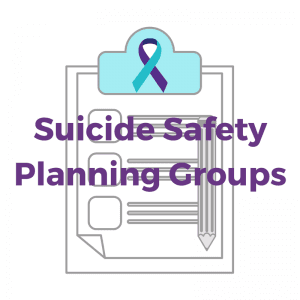#NSPM: Preventing Suicide with Safety Planning Groups at the Institute for Family Health, a Q&A with our Director of Suicide Prevention
September 28, 2017
September is National Suicide Prevention Month. Our Director of Suicide Prevention, Sarah A. Bernes, MPH, LMSW shared with us some information about a new service at the Institute – Suicide Safety Planning Groups.

A safety plan is a written, prioritized list of coping strategies and sources of support that patients can use to alleviate a suicidal crisis.[1]
Who should consider joining a suicide safety planning groups?
Safety planning is an effective intervention for people who have suicidal thoughts.[2] Offering the safety planning intervention in a group format helps combat the loneliness and isolation that people experiencing suicidal thoughts often feel. Patients report they find it helpful to be in a room with people that have had similar experiences to share what has helped them build lives worth living. Our mental health clinicians refer patients that have suicidal thoughts or have made a suicide attempt to the group.
What are the safety planning sessions like?
The Institute’s Safety Planning Group meets weekly for 90 minutes for 10 weeks. Groups are led by at least two therapists in order to maintain safety for the patients and staff, and ensure that staff can respond appropriately to patients in crisis. Each week, the therapists give patients handouts to be covered during that session and a copy of their personalized safety plan updated from the previous week. Safety planning has six steps, each of which is covered in at least one group session. Patients roleplay sharing their safety plan with loved ones and asking for help and we discuss ways to maximize mental health treatment and make sure the safety plan is accessible during a crisis.
How did the Institute for Family Health begin using this form of treatment for patients?
The Institute partnered with Dr. Marianne Goodman, Professor at Mount Sinai School of Medicine and Director of the James J. Peters VA Suicide Prevention Research and Care Center to use her Project Life Force (PLF) safety planning group curriculum. Dr. Goodman is testing the intervention with veterans[3] and this is the first time PLF has been used with civilians. The Institute piloted the program for 20 weeks at our Family Health Center of Harlem from March to the end of July 2017. During the pilot, 15 patients attended at least one group sessions, with many of them returning week after week. The group has now continued as a regular center service. Since our pilot began, Institute patients have reported increased skill development and use, and mental health clinicians appreciate high risk patients receiving additional weekly treatment contact. Many patients attend our other mental health groups and receive individual therapy and psychiatric services at the center. Currently the safety planning group is available to patients at our Family Health Center of Harlem, but we hope to expand to other locations soon. We also hope to identify peers who can co-facilitate the groups with a mental health clinician.
If you or someone you know is experiencing suicidal thoughts, please contact the National Suicide Prevention Lifeline at 1-800-273-TALK (8255).
[1] Stanley, B., & Brown, G. (2012). Safety Planning Intervention: A brief intervention to mitigate suicide risk. Cognitive and Behavioral Practice, 19(2), 256–264.
[2] Bryan, C. J., Mintz, J., Clemans, T. A., Leeson, B., Burch, T. S., Williams, S. R., & Rudd, M. D. (2017). Effect of crisis response planning vs. contracts for safety on suicide risk in U.S. Army Soldiers: A randomized clinical trial. Journal of Affective Disorders, 212, 264-272.
[3] https://clinicaltrials.gov/ct2/show/NCT02525575
Recent Topics